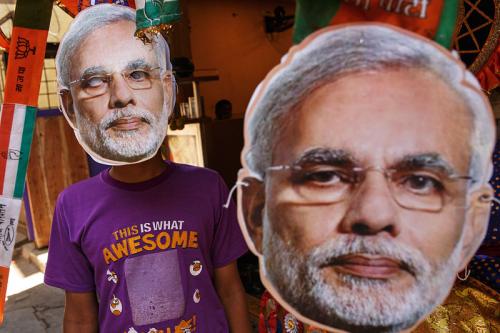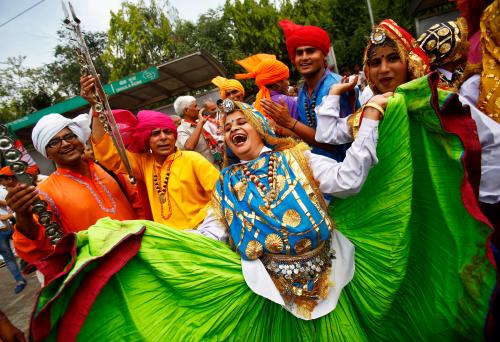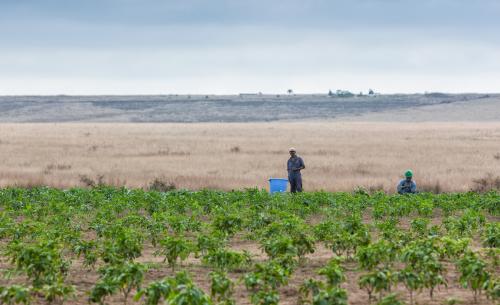The results are in: After six weeks of voting, the largest election in world history positioned Narendra Modi—the polarizing leader of the Bharatiya Janata Party (BJP)—as the new Indian prime minister, and appointed new parliamentary members to the 16th Lok Sabha.
Five hundred and fifty million Indians cast their ballots in the historic election that ended a heated, personality-driven campaign in the world’s largest democracy.
What does this outcome mean for India, the U.S. and the world? We asked Brookings experts to share their thoughts. Subir Gokarn—former deputy governor of the Reserve Bank of India—chimes in—as does Brookings India Fellow Shamika Ravi. Brookings Senior Fellow William Antholis, author of the new book Inside Out India China: Local Politics Go Global, provides insight on Modi’s background in combatting climate change.
For even more on the election, watch video of Brookings experts breaking down the election results from our May 19 event. You can also visit our India topic page for the most recent analysis on India, its elections, and what’s next for the world’s largest democracy.
Who is Narendra Modi?
Who is Narendra Modi? How will he govern? Is he the right person to lead India during this challenging time in its history?
Subir Gokarn: To put this into some historical perspective, five Indian prime ministers before Mr. Modi were chief ministers of states before they became prime ministers. Only one of them—Narasimha Rao—stayed for a full term. His term is actually a great precedent for Mr. Modi, because he initiated an economic reform process that his successor governments sustained until 2004. The economic boom of 2003-08 was the result of continuous reforms carried out by a series of governments. However, unlike Mr. Rao, Mr. Modi becomes prime minister straight out of his chief minister’s office. This is a strength in some ways —closer to the ground—but a weakness in others, for example unfamiliarity with the workings of the central government. His leadership of the BJP election campaign clearly demonstrates that he has the skills needed for his larger public responsibility. The size of his majority gives him the freedom to think long-term and strategize accordingly. The untested skill is his ability to balance multiple and frequently conflicting stakeholder interests. But, overall, from the pool of potential candidates, it is difficult to argue that he isn’t the best candidate for the job today.
Shamika Ravi: Narendra Modi has won an overwhelming majority in the 2014 general elections of India. So one can say that he is the most popular political leader in India today. The electorate of India has given him a clear mandate to govern—by that token he is the right person for the job. He is riding on enormous aspirations and promises of the population. What he does with this great opportunity remain to be seen.
The data from Gujarat indicates that he will run an efficient government. But one must also appreciate that Gujarat is one state of the Indian union and to extrapolate from there would be simplistic. Maneuvering an entrenched Delhi bureaucracy will be a challenge. Redefining center-state relationship by devolving more powers to state Chief Ministers will be a fundamental structural change that Modi will attempt. His immediate focus will be on selecting a group of ministers and functionaries to run a decisive government and to kick start a stalled economy by giving confidence to domestic and foreign investors.
On the Economy
India’s economy has been battling its worst slowdown in a decade, struggling with weak growth and high inflation.
However, one of Modi’s most notable successes as chief minister of Gujarat was his transformation of the state’s manufacturing base that contributed to economic growth.
What are the top things that the new government could do to rescue India’s economy from its slowest growth rates in a decade?
Shamika Ravi: Growth is an outcome, not a policy tool. The top priority for the new government has to be governance. An efficient and fast-moving governance structure is critical to restoring the dwindling investor confidence (both domestic and foreign investors) as well as arresting corruption. The new government, therefore, has to focus on bolstering infrastructure—both physical and financial which are critical to realizing full growth potential. In the medium run, the government has to address some major structural changes such as: overhauling the restrictive and archaic labor laws, administrative reforms and devolving powers to state governments. This is, by no means, an exhaustive list of recommendations.
What is fundamental in the long run, however, is investment into health and education in India. These are basic requirements for any developing economy and specifically for a government that aspires to pull a large section of the population out of poverty.
What challenges will Modi face in translating this success to economic growth throughout India?
Subir Gokarn: He has to ensure that the growth strategy is oriented towards employment. This means, apart from the strategic thrust on labour-intensive activity—manufacturing, construction, etc.—he has to focus on removing the many and multi-tiered barriers to investment and employment in these areas. This will require much cajoling and pressure on state governments and local authorities to contribute their part. While the BJP virtually swept the states of UP and Bihar, these will be run by regional parties for the next few years at least. These are the states with the maximum number of people looking for work. He will have to find a way to co-ordinate effectively with governments that are fiercely antagonistic to him to achieve the larger goals. To do this, he must leverage the legitimacy and goodwill that his big wins in the parliamentary elections have earned him to get the state governments to co-operate with him.
Shamika Ravi: For growth to benefit all sections of the society/economy, the government has to overwhelmingly emphasize efficient and fair governance. All sections of the society have to have equal access to good governance, and faith has to be restored in public institutions. Investments in health, education and infrastructure are critical.
Key challenges to realizing the full growth potential:
- Poor health and nutritional standards in the population
- Low levels of literacy and skill
- Low capacity of legal infrastructure—leading to delays and high costs
- Poor urban planning making it difficult for cities to accommodate an ever increasing rural-urban migration
- All pervasive gender inequality
How can the U.S. be a stronger partner on defense and economic issues?
Shamika Ravi: India-U.S. relations are crucial to the stability and prosperity of the Indo-Pacific region. Defense and economic cooperation between the two countries is critical to this. While India’s procurement of defense equipment from the U.S. has been expanding over the years, there can also be tremendous long-term gains from technology sharing. Some of India’s critical security concerns can also be addressed through America’s relations with Pakistan. U.S.-India relations will be critical to the success of America’s ‘pivot to Asia’ policy, as stated by President Obama.
On Foreign Policy
The new Modi government will be confronted with a series of international challenges that will have a direct bearing on its domestic policies and development agenda.
What should the foreign policy priorities of the new government be?
Shamika Ravi: Given the overwhelming mandate in the elections, the new government has to seize the opportunity and develop a clear foreign policy strategy. For a long time, India’s foreign policy has been individual-centric, where responses to external stimuli have been episodic rather than coherent with long-term strategic national interest. Indian foreign policy has to be well-defined and consistent with its internal diversity and strategic assets such as location.
Beyond India-U.S. relations, how should the new government deal with other key countries such as China, Pakistan, Afghanistan, etc.?
Shamika Ravi: While preserving its strategic autonomy, India must build its relations with the U.S. on the shared values of liberal and plural democracy. India’s foreign policy towards its neighbors has to be distinctly framed with due regard to geographical and cultural proximities and economic interdependence. Within this fundamental framework, India’s approach to its neighbors is defined below:
China:
- Resolving the border dispute should be top priority.
- Formulate a coherent foreign policy consistent with India’s strategic interest in the subcontinent, Southeast Asia and Indian Ocean, keeping national interests and international obligations.
- Calibrate trade and commerce links to reduce the current balance of trade.
Bangladesh:
- Bangladesh crucially impacts India’s northeast which is home to 45 million people. Given the high levels of trust deficit between the two countries today, priority has to be given to building mutual trust between the two countries rather than with individual leaders.
- Enhancing connectivity.
- Institutionalizing and augmenting the existing informal commercial and sociological links.
Pakistan:
- The main obstacle to improving India-Pakistan relations is the absence of strong state in Pakistan. Negotiating across multiple power centers which are not always aligned with each other is a fundamental impediment.
- India needs to explore opportunities where interests of the two countries converge.
- Serious attempts have to be made to overcome the bitter legacy of history which will require seeking reconciliation between the two ideas of Pakistan and India.
Afghanistan:
India has several security and commercial strategic interests in Afghanistan and enjoys significant leverage. India has high stakes in a stable Afghanistan and its foreign policy priority has to directed towards achieving this stability.Sri Lanka:
India’s foreign policy towards Sri Lanka has to be in sync with its larger national interest and international obligation in the Indian Ocean region rather than seen from the narrow lens of ethnic identities.Nepal:
India and Nepal share an overwhelming cultural cosmology. However, this has not been translated into building a strategic relationship between the two countries beyond individual leaders. The two countries have crucial mutual strategic interest and the new government’s priority has to be to define and build on these interests.
On the Youth Vote
65 percent of eligible Indian voters were under 35. More than 42,000 registered voters were between 18 and 19 years old.
How did this unprecedented youth demographic affect the election? What issues were the most important to them?
Subir Gokarn: Voting patterns suggest that, although the BJP/NDA had an absolute advantage over the Congress-UPA in all age groups, the gap was significantly wider in the younger age groups. This can be interpreted as a strong endorsement of the governance and development agenda that the BJP professed in its campaign. I think that the prospects of improved access to livelihoods was a key factor in the attraction of Mr. Modi to the younger voters, but this was perhaps reinforced by his effective positioning as a decisive, take-charge kind of leader, a personality trait that is so glorified in the popular media typically targeted to this group.
On Climate Change
Modi has billed himself as a climate change activist, creating a state-level ministry for climate, and publishing a book in 2010 called “Convenient Action: Gujarat’s Response to Challenges of Climate Change,” touting low-carbon investments.
Under Modi, will climate change be a state issue or a central issue, or both?
Subir Gokarn: Certainly the coastal states, including Gujarat, are already feeling the impact of rising sea levels and increasing salinity in ground water sources, so at least a coalition of these states will have to start working together on effective mitigation strategies. But the larger national strategic thinking and the country’s positions in international negotiations will be driven by the centre. Mr. Modi’s sensitivity to this issue will presumably bring it somewhat closer to centre-stage in the government’s policy priorities and resource allocations.
William Antholis: Modi was one of India’s most outspoken proponents of taking a leadership role on climate change. In addition to creating a state climate change ministry, he made significant investments in solar energy and hydro-power. That said, many critics have felt that his professed interest and commitment were high on rhetoric, which is always more convenient than actual actions. According to Indian press reports, his much publicized climate ministry is now defunct, and its long-overdue Climate Change Action Plan was “junked.”
He faces a choice. An overhaul of central government ministries, with an emphasis on climate, would favor nuclear, renewables, natural gas, and a major investment in smart grid technologies. That may not provide the cheap and easy reliance on coal and petroleum that fueled Gujarat’s growth. Or, he could demand that the states take on this challenge. In exchange for central resources, they would have to complete their state action plans for climate change—few of which have been completed. That would mean demanding the climate action that may have proven to be less-than-convenient in Gujarat. On energy and climate change, now that Modi is elected, he will face hard choices. It will not only be interesting to see which he chooses—it will be vital. India’s growth and the world’s climate hang in the balance.









Commentary
Welcoming Indian Prime Minister Modi to the Global Stage: Brookings Experts Weigh In
May 19, 2014